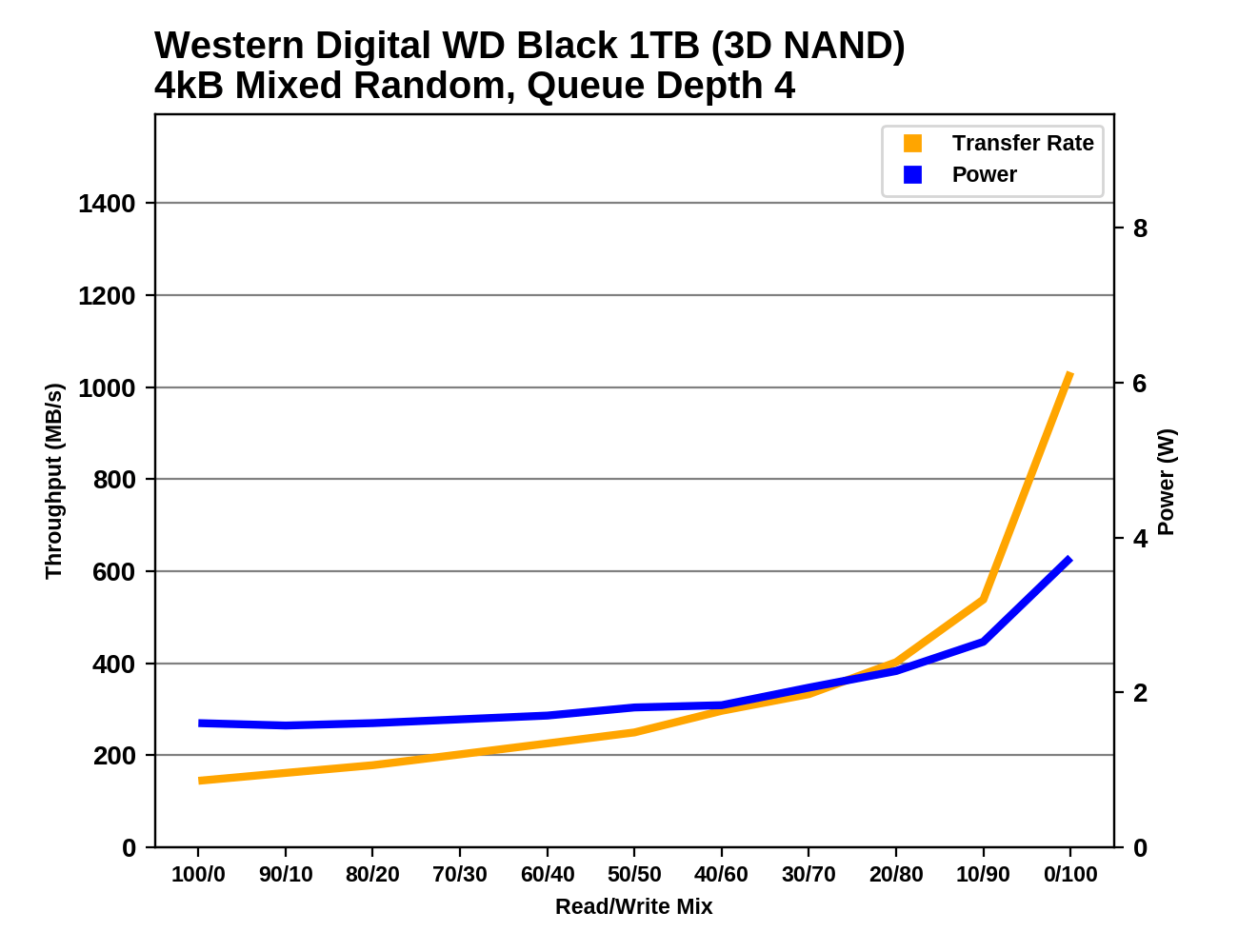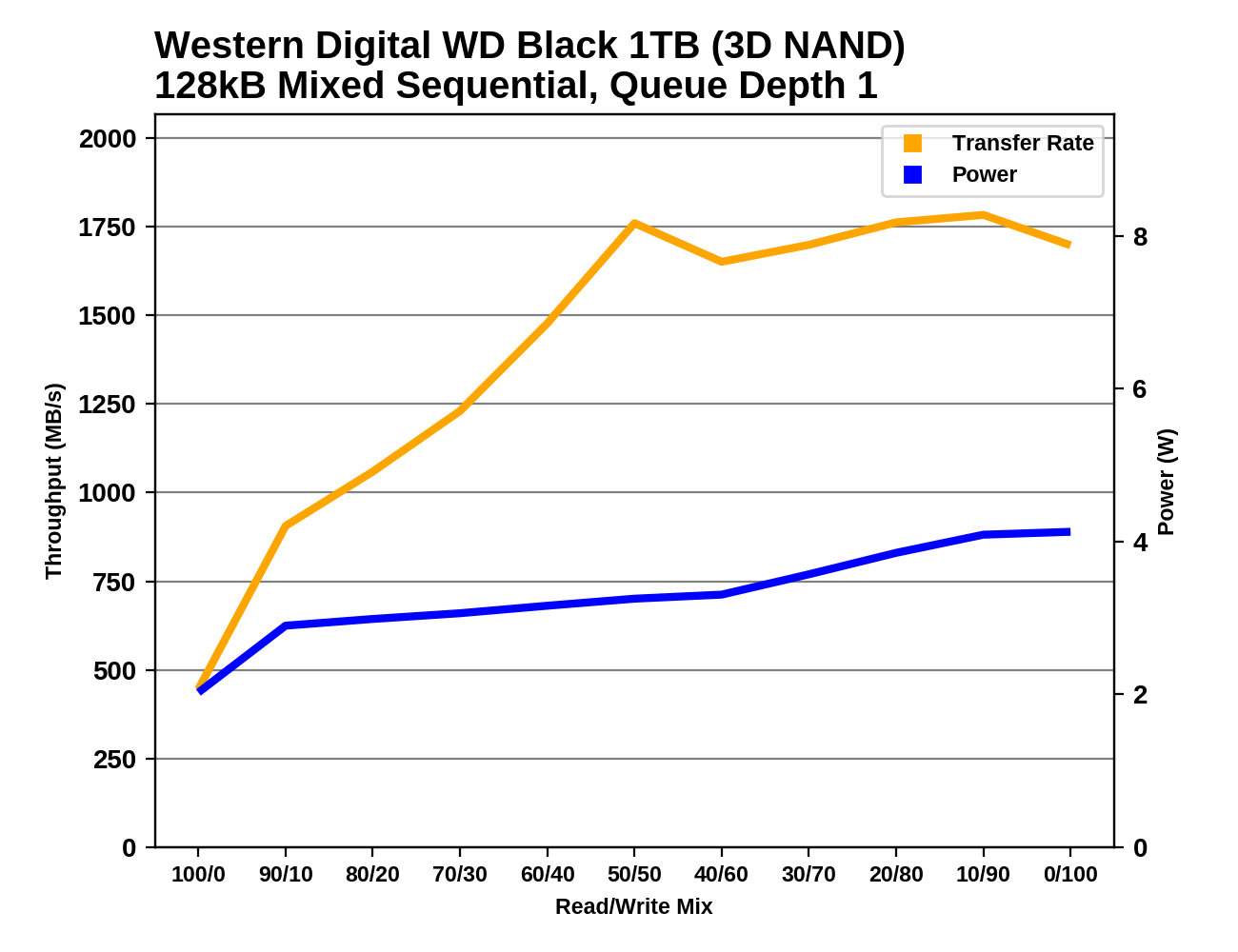The Western Digital WD Black 3D NAND SSD Review: EVO Meets Its Match
by Ganesh T S & Billy Tallis on April 5, 2018 9:45 AM EST- Posted in
- SSDs
- Storage
- Western Digital
- SanDisk
- NVMe
- Extreme Pro
- WD Black
Mixed Random Performance
Our test of mixed random reads and writes covers mixes varying from pure reads to pure writes at 10% increments. Each mix is tested for up to 1 minute or 32GB of data transferred. The test is conducted with a queue depth of 4, and is limited to a 64GB span of the drive. In between each mix, the drive is given idle time of up to one minute so that the overall duty cycle is 50%.

The WD Black offers great mixed random I/O performance, but it is still slightly slower overall than the best drives from Samsung, and the Optane SSD is in an entirely different league.
 |
|||||||||
| Power Efficiency in MB/s/W | Average Power in W | ||||||||
The WD Black's power efficiency on the mixed random I/O test is about the same as that of the Samsung 960 PRO, and close to the Optane SSD in spite of the vast difference in absolute performance level.
 |
|||||||||
The performance of the WD Black grows very slowly as the workload shifts from reads toward writes, but near the end of the test the good SLC write caching implementation gives the WD Black steep gains. Power consumption is under 2W for most of the test and doesn't quite reach 4W at the very end.
Mixed Sequential Performance
Our test of mixed sequential reads and writes differs from the mixed random I/O test by performing 128kB sequential accesses rather than 4kB accesses at random locations, and the sequential test is conducted at queue depth 1. The range of mixes tested is the same, and the timing and limits on data transfers are also the same as above.

The mixed sequential workload performance of the WD Black is surprisingly good, just barely behind the Optane SSD and far ahead of almost all flash-based SSDs.
 |
|||||||||
| Power Efficiency in MB/s/W | Average Power in W | ||||||||
The WD Black draws about the same power as other SSDs during the mixed sequential test, and combined with the great performance that translates to a huge lead in power efficiency.
 |
|||||||||
The performance scaling pattern of the WD Black on the mixed sequential test is quite unusual. Many drives show a bathtub curve with peak performance at either end of the test when the workload is pure reads or pure writes, and the worst performance in the middle of the test. By contrast, the WD Black starts out rather slowly but rapidly speeds up during the first half of the test, and stays near full performance for the entire second half.










69 Comments
View All Comments
Cooe - Friday, April 6, 2018 - link
This is why the 250GB 960 EVO (and inevitably for the new WD Black as well) is far and away the most popular SKU just about everywhere. At around $110-120 vs $80-90, you're only paying a premium of around 20-25% over an equivalent tiered SATA III drive (ala an 850/860 EVO), though yes, you are sacrificing your sequential write speeds past the 13GB Turbowrite cache to just 300MB/s to get that comparatively tiny price premium for good NVMe vs SATA-III ratio.Tbh though in most general consumer PC workloads the above simply isn't an issue, as sustained writes of >13GB are few & far between, and the cache turnover speed while idling is speedy quick. I think this is exactly the reason why Western Digital & SanDisk adopted the kind of handicapped nCache 2.0 into a very Turbowrite-esque system with nCache 3.0 (but more like 850 EVO's simplier static TW cache just a lot bigger, rather a dynamic one like the 960 EVO uses).
Dragonstongue - Thursday, April 5, 2018 - link
competition is good, but not if they all want to keep pricing within a few $ of each other IMO.for nvme/M.2 drives they need to make sure is more universal that it is more plug and play so consumers can be assured it will work on their motherboard as a bootable OS drive right off the bat without driver specific support (quite a few drives quite a few no matter on Intel or AMD chipset seem to have this issue hence they need more plug and play support)
costs more than a normal sata based one (performance is much higher though that does not always mean can see this difference) but having to screw around making the bios/windows able to use the drive in question sucks (not saying this is a problem with this specific model, but it is a problem)
nice write up though ^.^
PeachNCream - Thursday, April 5, 2018 - link
I agree with you on pricing. It would be good if WD had priced their drive a bit lower in order to force Samsung to respond since they have a competitive product, but they have to get a return on development costs so it's safe for them to match Samsung's price. I don't like it because the consumer isn't realizing a benefit in additional competition if neither company budges on cost, but I can understand the business justifications that are probably behind it.Cliff34 - Thursday, April 5, 2018 - link
What I do wish is that the m2 sata drives should be the same price as sata ssd. After all, the specs are the same just diff forms. Too bad for us consumers.The_Assimilator - Friday, April 6, 2018 - link
M.2 SATA drives should cost *less* than their 2.5" equivalents, and the 2.5" drives should simply be an M.2 drives in an enclosure with an M.2-to-SATA connector.Cliff34 - Saturday, April 7, 2018 - link
It should but it doesn't. My guess is because m2 form is a niche market because most computer accept SATA. Therefore, companies can charge more because they can get away with it. Unless there's a huge swing of adoption of m2 form for desktop and laptops, m2 will always cost more than SATA.zodiacfml - Friday, April 6, 2018 - link
True.wr3zzz - Thursday, April 5, 2018 - link
WD's pricing strategy is probably indicative that current demand for NVMe is still outpacing supply.Arbie - Thursday, April 5, 2018 - link
Great article and follow-up analysis of the tests; thanks.iwod - Thursday, April 5, 2018 - link
What are the difference in real world usage? We thought we needed better QD1, and even that doesn't return any significant difference in optane.